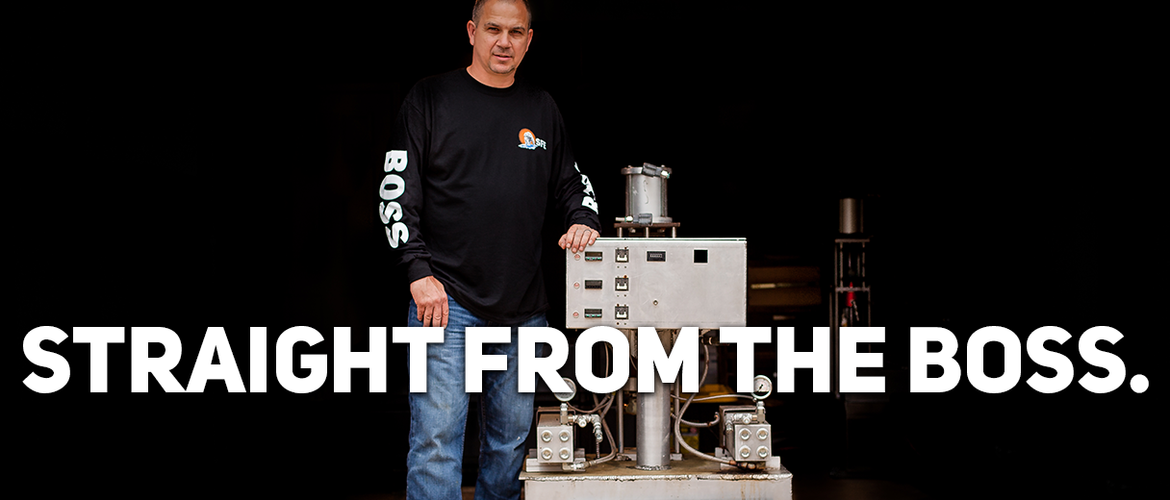This week, we finish out our step-by-step hose heat troubleshooting guide.
If you haven’t read Part 1 of our guide yet, you can find it here.
Both posts accompany our Hose Heat Troubleshooting video and flow chart, so make sure to check those out before reading this post, too!
Alrighty. Let’s pick up where we left off and get you back to your spray foam job!
So far, you still haven’t pinpointed your hose heat issue after:
- Checking the amperage in the hose wires.
- Checking the voltage coming from the machine (after the fuse and solid-state relay).
- Checking the voltage directly from the hose heat transformer.
It’s now time to test that your machine is receiving adequate power.
Diagnose Spray Foam Hose Heat Issues (Continued)
Step 4: Test Voltage from the Hose Heat Breaker
First, ensure your hose heat breaker is switched on and your machine is calling for hose heat.
Once you’ve determined that the hose heat transformer is not producing adequate voltage (discovered in Step 3), move to the top compartment of the machine, and remove the cover.
With your multimeter set to read AC voltage, place the probes on the top two posts, which connect the hose heat breaker to power. This will determine the voltage running to the hose heat breaker from the machine’s main breaker.
If this reading is less than the necessary 240 volts, you will need to test the main breaker and verify that adequate power is entering the machine.
Step 5: Test Voltage from the Main Breaker
Place your multimeter probes - set to read AC voltage - on the two wires coming into and the two wires going out of the main breaker to determine if the full 240 V are entering the machine. The full voltage is necessary to heat your spray foam hose properly.
If the incoming wires read 240 V and the outgoing wires read less than 240 V, the main breaker needs replaced. Issue diagnosed!
If neither the incoming nor outgoing voltage reads the full 240 V, there is likely an issue with your power source. You’ll need to find a source of power that is adequate for your spray foam machine’s draw.
Step 6: Test the Voltage from the Isolated Relay
If your BOSS machine’s hose heat transformer (in the lower compartment) is receiving the full 240 V from the power source, but the voltage between the red wires (after the fuse and the relay) is inadequate, you need to determine whether the problem lies with the fuse or the relay.
To do this, you’ll need to isolate both the fuse and the relay. We’ll start with the relay.
With your multimeter (still) set to read AC voltage, place the probes on the black wire going into the fuse holder and the red wire coming out of the solid-state relay.
This isolates the relay by testing between the two sides of the circuit, via the lead coming directly from the transformer and the lead after the power has moved through the relay.
A low or non-existent reading between these two wires indicates that the problem lies within your relay. Mystery solved! Replace the relay, and you’re back in business.
If you read the correct voltage between these two points, you can eliminate the relay as the source of the problem. Move on to Step 7 to isolate the fuse.
Step 7: Test the Voltage from the Isolated Fuse
The hose heat transformer is receiving 240 V from the power source, and the solid-state relay is working correctly - you’ve narrowed down your hose heat problem to the fuse.
Let’s isolate the fuse to verify your hypothesis.
Like before, ensure your multimeter is set to read AC voltage. Then, place the probes on the black wire leading into the solid-state relay and the red wire coming out of the fuse holder to isolate the fuse.
If you receive no reading (or a significantly lower reading than expected), the fuse is the issue. Finally! Replace the fuse, and you’re back to spraying!
If the reading shows the correct voltage, you know that the fuse is not causing your hose heat issue.
Assuming you have followed all of the steps up to this point, you have either found the issue with your hose heat or discovered that the electrical components are not the problem. If the latter is the case, the heating issue lies within the hose itself.
Step 8: Visually Check the Hose Connection
No matter where you place your multimeter probes along the circuit - as long as one probe is on the A-side and one probe is on the B-side - the voltage reading should be the same.
Electricity needs to move along a complete - or closed - circuit to work correctly, however.
If there is a break or disconnection in your power lines at any point along your hose, heating issues will occur.
Butt splices connect the power lines along the length of your hose and allow for proper heating. If a line has come loose from the splice connector, the circuit is broken. These splices are located at hose length joints and the end of the hose.
The most likely place for a circuit break in your lines is a butt splice connection - so these should be the first locations you check.
When inspecting your hose, you want to make sure to turn the hose heating breaker OFF.
If there is a loose connection, repairs will need to occur without power running through the lines.
While you check for connection issues between lengths of hose, also check that your machine’s Temperature Sensing Unit (TSU) wire is secured in the hose. If your TSU wire has pulled free of the hose, your hose heating issue may be a temperature sensing issue.
If you know there is a break in the hose power lines, but it is not visible at the joints or ends, you will want to check for line continuity to narrow down the break’s location.
Step 9: Test Hose Continuity
After inspecting your hose - to no avail - the next step is to test for line continuity and determine the location of the circuit break.
Start by ensuring that the hose heat breaker is OFF.
Then, expose the lines at both ends of the hose, on both the A and B sides.
Continuity is determined by testing resistance, and resistance is measured in ohms (Ω) - so set your multimeter to read ohms. (To read up on resistance, refer to Part 1 of this post.)
Focus first on figuring out whether the line break is on the A-side or the B-side of the hose.
To do that, put one multimeter probe on one end of the A-side line and the other probe on the other end of the A-side line. If you receive a reading, you know that there is continuity along the entirety of that side and can move on to checking the B-side.
If you place one multimeter probe on one end of the B-side line and the other probe on the other end of the B-side line and receive no reading, then you know that the break in your line is along the B side of the hose.
Once you’ve narrowed down the break location to the B-side of your lines, test the continuity of the B-side at each joint until you find the section of hose that is causing the problem. After locating the correct section of hose, you can dig into that section to find - and fix - the break.
Testing the continuity and narrowing down the section of line that needs work will save you countless hours and help get you back to spraying faster. (You’re welcome.)
External Hose Heat Transformer
If your spray foam machine is plugging along, but your hose heat transformer is no longer up to snuff, we have a solution for you!
The best part? You don’t need to purchase a whole new machine to keep spraying!
Everything else still works well - all you need is a new hose heating assembly, right? Right!
Well, as always, Spray Foam Equipment & Manufacturing has got your back!
And, lucky you, it won’t cost you an arm and a leg! (We only accept US Dollars, anyway…so win-win.)
We make an external hose heat assembly with a digital controller that will simplify your life and save you money.
That entire lower compartment assembly that BOSS machines come with? You know - the hose heat transformer, voltage leads, fuse holder, fuse, solid-state relay - all of it!
We put a separate housing around it, added the digital controller that comes on all of our BOSS spray foam machines, and got it ready to hook up to your existing machine! It’s a complete package - and it looks great, too!
If our external hose heater sounds like what you need, check it out here!
And remember - if you are struggling with this process and need some help, reach out to us!
Our trained staff will gladly help you.
If you’ve fixed your hose heat issue, fantastic! We hope your experience has been a simple one!
Conclusion
We hope that our step-by-step guide has helped you successfully diagnose the issue with your spray foam hose heat.
Keep our Hose Heat Troubleshooting video & flow chart handy, just in case, and get back to spraying!
If you have more questions, don’t hesitate to contact our highly-trained technicians!
As always, Spray Foam Equipment & Manufacturing is here for you.
Let us know how we can help!
Until next time, SPRAY ON!
- The Team at BOSS



